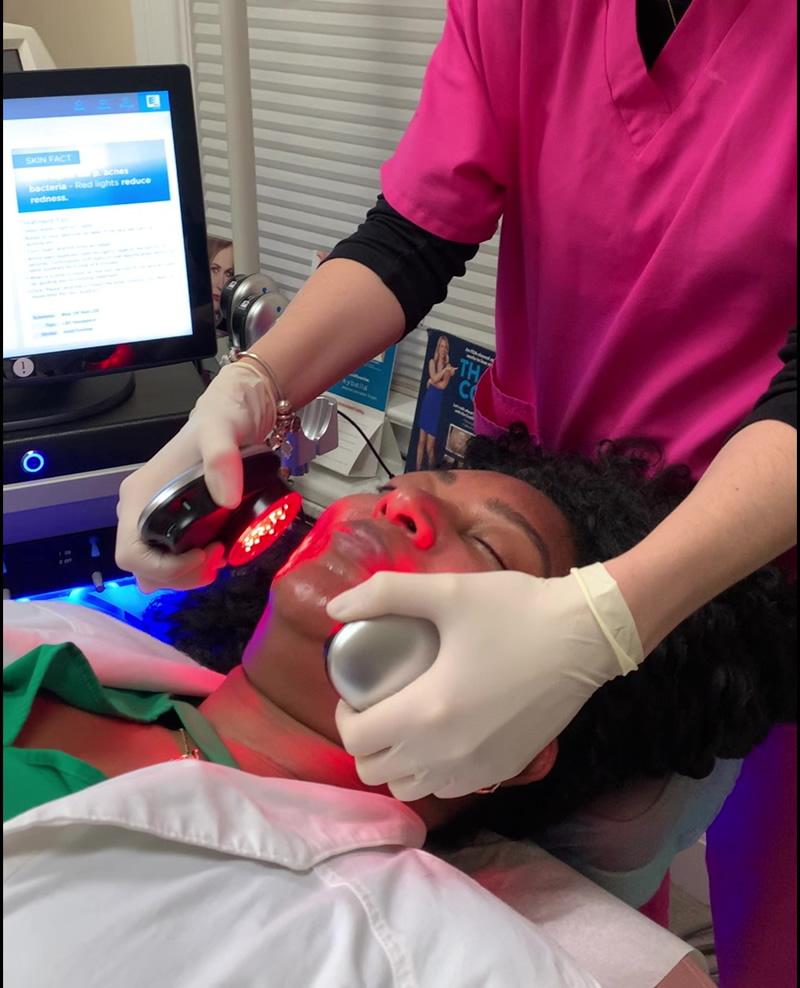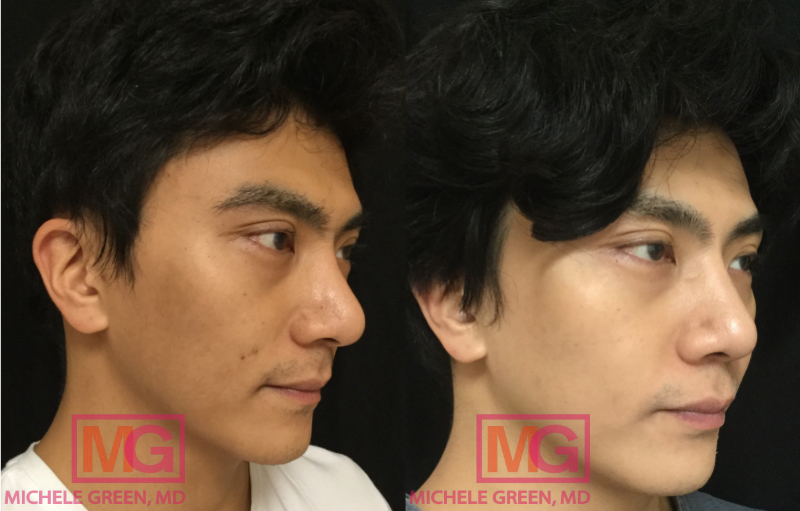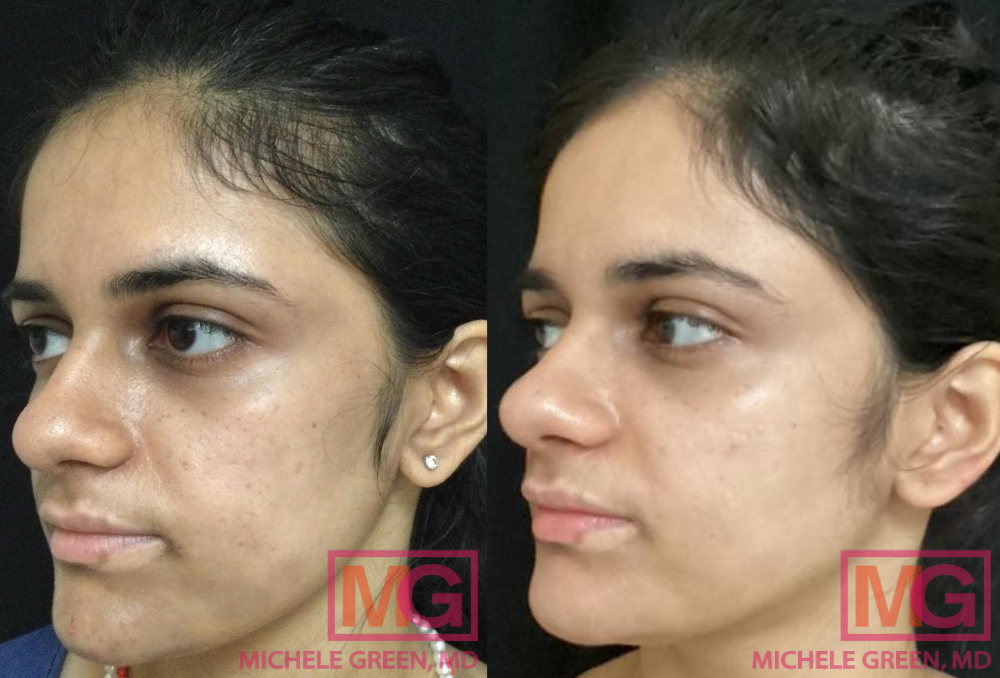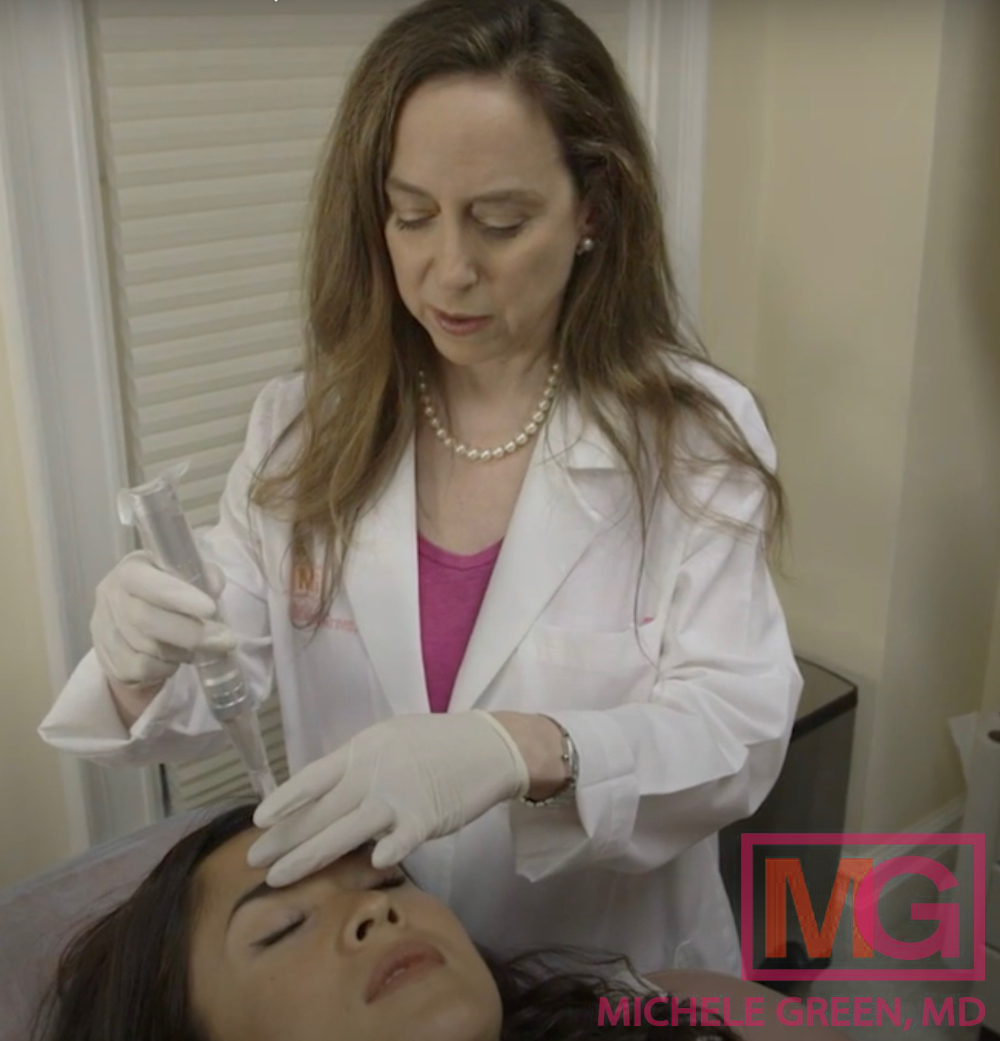Microneedling vs. HydraFacial vs. Chemical peel
The field of cosmetic dermatology offers a host of skin rejuvenation treatments that can address a variety of skin conditions and provide optimal results with zero downtime, including chemical peels, HydraFacial, and Microneedling treatments. These popular non-invasive skincare treatments provide healthy, glowing skin and can improve skin health and the appearance of fine lines, acne scars, large pore size, dull skin, and hyperpigmentation. To guarantee safety and the best skin rejuvenation results, it is important to have skincare treatments with an experienced dermatologist, such as Dr. Michele Green in New York City.
Chemical peels, HydraFacial, and Microneedling treatments are unique treatment options for skin rejuvenation that provide a host of benefits and can be customized to patients’’ skin types. The HydraFacial treatment is a three-step, medical-grade facial that involves deep cleansing, gentle exfoliation, and intense hydration through the extraction of impurities and infusion of specialized antioxidant serums via Vortex technology. Chemical peels involve the topical application of a chemical solution to the skin’s surface, which increases the rate of skin cell turnover, stimulates collagen production, and results in chemo-exfoliation. Microneedling, also known as collagen induction therapy, entails using a handheld device containing fine needles to create punctures on the skin’s surface. These micro-injuries stimulate new collagen production and allow for the enhanced absorption of specialized skin rejuvenation serums. Dr. Green customizes the skincare treatments of her patients to ensure they achieve optimal results.
Dr. Michele Green is an internationally renowned board-certified dermatologist with over two and a half decades of experience providing some of the world’s most discerning individuals with the best treatments for skin rejuvenation, including chemical peel, HydraFacial, and Microneedling treatments. Dr. Green takes a holistic approach and embraces a less-is-more philosophy regarding skincare treatments, customizing each patient’s protocol to suit their particular needs and aesthetic goals best. She is consistently identified as one of New York City’s best dermatologists by Super Doctors, Castle Connolly, New York Magazine, and the New York Times for her dedication to her patients and expertise. When you consult with Dr. Green at her private, boutique dermatology office in Manhattan’s Upper East Side neighborhood, she will work with you to create a personalized skincare treatment plan so that you look and feel like the very best version of yourself.

What is a HydraFacial treatment?
A HydraFacial is a three-step, medical-grade facial designed to do a deep cleanse, gently exfoliate, and intensely hydrate the skin. HydraFacial is a non-invasive treatment similar to microdermabrasion. However, instead of relying on micro-crystals to exfoliate the skin’s surface, HydraFacial relies on a handpiece equipped with Vortex fusion technology. The Vortex technology allows for the active infusion of special moisturizing and antioxidant serums and the extraction of dead skin cells and impurities from the pores.
HydraFacial is an excellent treatment option for improving overall skin health, dull skin, uneven skin texture, and more. The first step in the HydraFacial treatment is the deep cleansing of the skin through suctioning of dirt, debris, dead skin cells, and other impurities. The second step involves the application of a chemical peel, a combination of salicylic and glycolic acids, to increase the rate of skin cell turnover, stimulate collagen production, and break up the excess oil contributing to clogged pores. Then, extractions and exfoliation occur. The third step of the HydraFacial is the infusion of rich antioxidants and hydrating serum to nourish the skin, reinforce the skin’s natural protective barrier, and protect against toxins or environmental irritants from penetrating the skin. The HydraFacial is a gentle yet powerful skincare treatment that is safe and effective for all skin types, including sensitive skin.
The HydraFacial experience can be customized to address specific skin concerns and boost anti-aging benefits using a variety of HydraFacial Boosters. The Britenol booster contains Alpha Arbutin, a naturally occurring skin brightener, and vitamin C, a powerful antioxidant to lighten hyperpigmentation (sun spots and age spots) and provide glowing skin. The Dermabuilder booster contains a blend of peptides to boost collagen production in the skin to restore elasticity, improve skin tone, and diminish signs of aging. Dr. Green will select the appropriate HydraFacial Booster serum for your skin care treatment, depending on your specific skin condition.
What is Microneedling?
Microneedling treatment, also known as collagen induction therapy, involves using a handheld device containing fine needles to create punctures on the skin’s surface. These micro-injuries stimulate the body’s natural wound-healing response, which leads to increased collagen and elastin production. The skin rejuvenation results of Microneedling include a reduction in fine lines and pore size, a more even skin tone, enhanced elasticity, and a more radiant, youthful appearance. Microneedling also helps decrease the appearance of skin conditions such as sun damage, wrinkles, acne scars, and pigmentation.
The micro-injuries in the skin also allow for the enhanced absorption of specialized skincare serums. Microneedling treatments can be enhanced by topically applying Platelet Rich Plasma, or PRP, to the skin’s surface after the Microneedling device is used. PRP is a serum derived from a sample of the patient’s blood, which is spun in a centrifuge to separate it from the red blood cells. PRP has a high concentration of epidermal growth factors, which promote enhanced healing and further boost new elastin and collagen production for even more dramatic results in terms of skin rejuvenation.
Microneedling treatment can also be customized for patients who are primarily interested in treating hyperpigmentation by pairing Microneedling with a depigmenting serum. Whether it be melasma, sun damage, post-inflammatory hyperpigmentation, acne scarring with pigmentation, or other skin discoloration, a Microneedling treatment with depigmenting serum is a safe and effective cosmetic procedure for achieving an overall more even skin tone and healthy, radiant complexion. The depigmenting serum used in the private dermatology office of Dr. Michele Green is a unique blend of powerful yet gentle skin-brightening agents that work against melanocyte activity in the skin. Most patients require a short series of Microneedling treatments, usually between 3-6 sessions, to achieve their final desired results.
One of the biggest benefits of Microneedling for skin rejuvenation is that there is almost no downtime involved. However, following a Microneedling treatment, Dr. Green advises her patients to refrain from applying their normal skincare products to the skin’s surface for two days and instead use just hyaluronic acid serum. Hyaluronic acid is a naturally occurring component in the skin that provides essential hydration. The moisturizing properties of hyaluronic acid serum will help promote healing and prevent irritation following Microneedling treatment.

What is a Chemical peel?
Chemical peels are a resurfacing skin rejuvenation treatment that works by accelerating the rate of skin cell turnover and stimulating new collagen production. During a chemical peel treatment, Dr. Green applies a topical chemical solution to the skin’s surface, which causes a chemical reaction on the skin to exfoliate away dead skin cells and promote the generation of new, healthy skin cells that are more even in tone and texture. Chemical peels differ from each other in the type of chemical solution used and the depth at which they penetrate the skin. Common types of chemical peels include glycolic peels, mesopeels, Cosmelan, trichloroacetic acid peels, VIPeels, and dermamelan. Chemical peels are usually classified into three different types: superficial peels, medium chemical peels, and deep chemical peels. Usually, the deeper the chemical peel, the longer the downtime.
Chemical peels can be used to address a wide variety of skin conditions and concerns. Patients may benefit from a chemical peel treatment if they have signs of sun damage or the natural aging process, such as fine lines, wrinkles, uneven skin tone and texture, and dull skin. A short series of chemical peel treatments can significantly improve general skin texture and radiance. This customized skincare treatment can also be used to address issues of hyperpigmentation, including sun damage, age spots, melasma, rosacea, and freckles. Chemical peel treatment can also be used to treat active acne breakouts, as well as reduce acne scarring.
Mesopeels
A Mesopeel is a specially formulated chemical peel that is gentle enough for all skin types, including sensitive skin. Mesopeels can successfully address many types of hyperpigmentation by influencing melanocyte activity, exfoliating the skin, and stimulating new collagen production. Melanocytes are the skin cells that are responsible for producing pigment. Mesopeels are commonly used to treat delicate areas of the body, including the underarms, groin, inner thighs, face, and under-eye areas. This allows Dr. Green to treat hyperpigmentation in areas that would otherwise be too sensitive to treat with traditional chemical peels. To achieve ideal skin rejuvenation results, patients usually require an initial series of 3-6 Mesopeel chemical peels, each spaced about four weeks apart. Dr. Green will create a particular skincare regimen for you to follow during and after chemical peel treatments to ensure that you can maintain your healthy, glowing skin. This always includes limiting sun exposure and utilizing proper sun protection, including broad-spectrum sunscreen. When you have Mesopeels with Dr. Green at her private dermatology office in NYC, she will provide you with all of the pertinent aftercare information and a personalized skincare protocol for achieving and maintaining ideal results.
Trichloroacetic Acid (TCA) Chemical Peels
TCA, or Trichloroacetic acid, is the most common solution used for medium-depth chemical peels in cosmetic dermatology. A medium-depth peel exfoliates the outermost layers of skin (epidermis) and the immediate underlying layers (upper dermis). The strength of a TCA chemical peel used by a dermatologist ranges from 10-50%. High concentrations of TCA may be used for a deeper chemical peel, affecting more of the layers of the dermis than a medium-depth peel. The amount of downtime required following a TCA chemical peel can vary depending on the strength used, ranging from one day of downtime with a light chemical peel to up to two weeks for a deeper peel. TCA chemical peels are an ideal treatment option for improving skin tone and texture. They can target concerns including fine lines, acne scars, active acne breakouts, large pore size, hyperpigmentation, and various other signs of aging. The TCA chemical peel is one of the most popular skincare treatment options offered at Dr. Green’s private boutique dermatology office in Manhattan’s Upper East Side neighborhood.

Cosmelan
The Cosmelan peel is a treatment designed to address melasma, a skin condition characterized by patchy hyperpigmentation. Dr. Green also uses Cosmelan to reduce other pigmentation issues, including post-inflammatory hyperpigmentation and sun damage. Cosmelan is a unique chemical peel that is applied as a mask, which contains 51 active ingredients. These ingredients include tyrosinase inhibitors, which inhibit the production of pigment in the skin, and other skin-lightening agents to restore an even skin tone. The Cosmelan peel is a two-part process involving the in-office application of the chemical peel mask, followed by adherence to an at-home skincare regimen. It is required to wear the initial Cosmelan mask for several hours, which Dr. Green designates based on your skin type and the severity of your hyperpigmentation or melasma.
Which is better, HydraFacial or chemical peel? HydraFacial vs. Chemical peels
Chemical peels and HydraFacial both improve skin health and appearance by exfoliating away dead skin cells, excess oil, and other impurities. This makes either treatment option a great choice for treating and preventing acne breakouts and dull skin. These non-invasive skincare treatments also stimulate new collagen and elastin production, which can improve various signs of sun damage and aging, including fine lines, large pore size, hyperpigmentation, and an uneven skin tone. The result of having either a chemical peel or HydraFacial is healthy, glowing skin. The right treatment option for you may be determined by your skin type and the amount of downtime you can afford. While there are superficial chemical peels that involve little downtime, a HydraFacial may be recommended over a chemical peel if you have very sensitive skin or an inflammatory skin condition, such as eczema or psoriasis.
Which skincare treatment is better, HydraFacial or Microneedling? HydraFacial vs. Microneedling
Microneedling and HydraFacial are both safe and effective skin rejuvenation treatment options for patients of all skin types and tones, offering a myriad of benefits for skin health and appearance. These two non-invasive treatments can easily be integrated into the same skin rejuvenation plan as complementary procedures. HydraFacial is the perfect skincare treatment to quickly deliver a deep cleansing, gentle exfoliation, and intense hydration to the skin, resulting in healthy, glowing skin in as little as thirty minutes. There is zero downtime involved with HydraFacial, and it offers immediate skin rejuvenation results, making it a great treatment option for patients who want something quick, easy, and relatively shorter-term results. Microneedling, a.k.a. collagen induction therapy, is an excellent treatment option for addressing textural acne scars and signs of sun damage and aging, including fine lines, dull skin, an uneven skin tone, large pore size, and skin laxity. There is a short period of downtime with Microneedling, which usually involves mild side effects of redness, swelling, and flaking or peeling for up to two days. Most patients need a few Microneedling treatment sessions, usually between 3 and 6, each spaced one month apart, to get the best cosmetic results. Patients may choose to have Microneedling and HydraFacial if they’re looking to maximize the skin rejuvenation results they’re able to achieve and maintain.
Which is better, Chemical peel or Microneedling?
Microneedling and chemical peels are two non-invasive resurfacing treatment options for skin rejuvenation that can be used to address a host of skin conditions, including irregular pigmentation, fine lines and wrinkles, large pore size, sun damage, uneven skin tone, dull skin, and acne scars. While the two treatment options can address many similar skin conditions, they work in very different ways. Microneedling, also referred to as collagen induction therapy, stimulates collagen and elastin production by creating micro-injuries on the skin’s surface. Chemical peels involve the topical application of specific acids onto the skin for chemo-exfoliation and skin rejuvenation. Both treatment options may be associated with mild side effects of redness, peeling or flaking, and swelling, which typically resolve within two days of the procedure. The short downtime involved with both treatment options makes it easy for patients to schedule a series of treatment sessions, which will guarantee that optimal skin rejuvenation results are achieved.

Which facial treatment is best for me?
Your skin is unique, and so is the combination of skincare treatments that you should engage with to keep it looking its very best. The best skin rejuvenation treatment of all is usually a customized combination determined by a board-certified dermatologist like Dr. Green, who has the expertise and experience to select the cosmetic treatment options and skin care products best suited to your skin type and your unique skin condition. The right skincare treatment can transform your skin health and appearance by clearing the pores, reducing the appearance of fine lines and wrinkles, minimizing hyperpigmentation, and eliminating other signs of sun damage and aging. By stimulating blood circulation, promoting new collagen and elastin production, and providing essential skin hydration, a non-invasive skincare treatment is an ideal treatment option for achieving healthier, more radiant, and youthful-looking skin in a quick procedure with no downtime. One of the greatest advantages of having skin rejuvenation treatments with a dermatologist is that there are many different customizable treatment options. During your consultation with Dr. Michele Green at her private, boutique dermatology office in Manhattan’s Upper East Side neighborhood, you will have the opportunity to discuss your cosmetic goals and establish a treatment plan for skin rejuvenation that is personalized to meet your skin type and needs.
How to get started with personalized skincare treatments today
The field of cosmetic dermatology offers a host of skin rejuvenation treatments that can address a variety of skin conditions and provide optimal results with zero downtime, including chemical peels, HydraFacial, and microneedling treatments. These popular non-invasive skincare treatments provide healthy, glowing skin and can improve skin health and the appearance of fine lines, acne scars, large pore size, dull skin, and hyperpigmentation. To guarantee safety and the best skin rejuvenation results, it is important to have skincare treatments with an experienced dermatologist, such as Dr. Michele Green in New York City.
Dr. Michele Green is an internationally renowned board-certified dermatologist with over two and a half decades of experience providing some of the world’s most discerning individuals with the best non-invasive skincare treatments for rejuvenation, including microneedling, chemical peels, and HydraFacial. Regarding skin rejuvenation, Dr. Green takes a holistic approach and embraces a less-is-more philosophy, customizing each patient’s plan to incorporate the treatment options and skin care products best suited to their skin condition, needs, and goals. She is consistently identified as one of New York City’s best dermatologists by Castle Connolly, New York Magazine, Super Doctors, and the New York Times for her dedication to her patients and expertise. When you consult with Dr. Green at her private, boutique dermatology office in Manhattan’s Upper East Side neighborhood, she will work with you to create a skin rejuvenation treatment plan that leaves you looking and feeling like the best version of yourself. To schedule a consultation with Dr. Green and get started with your personalized skincare treatments, call the office at 212-535-3088 or contact us online today.
 212-535-3088
212-535-3088